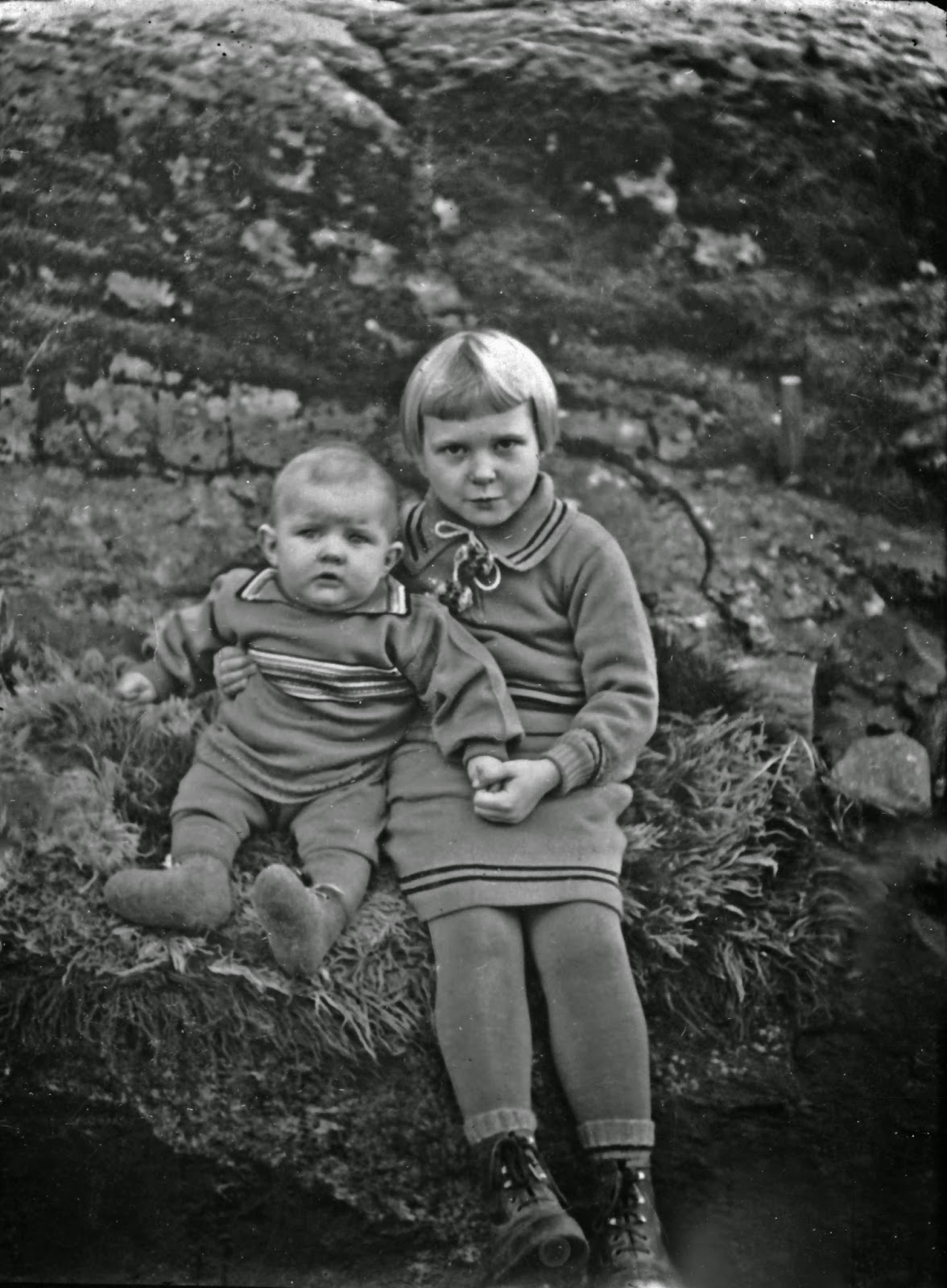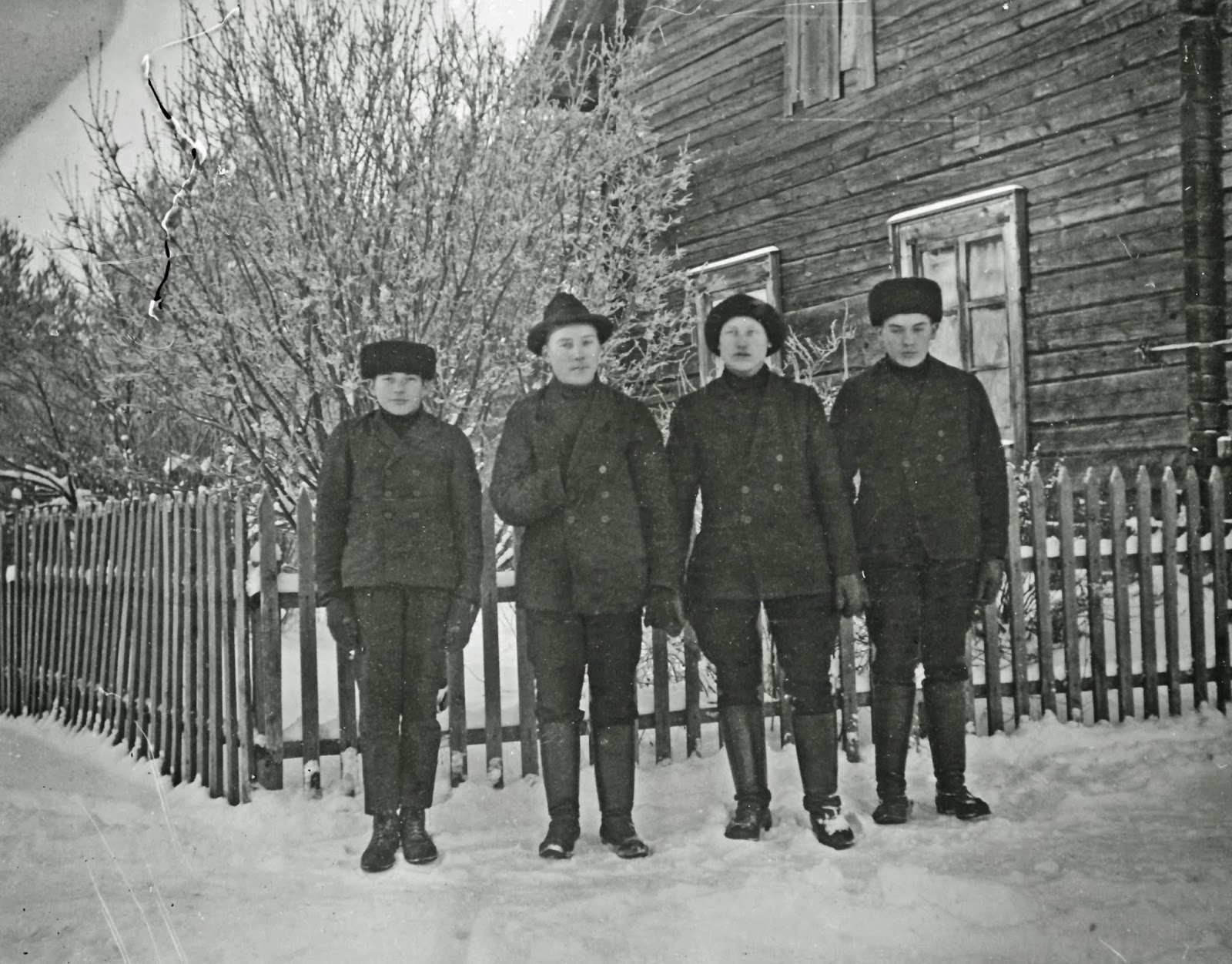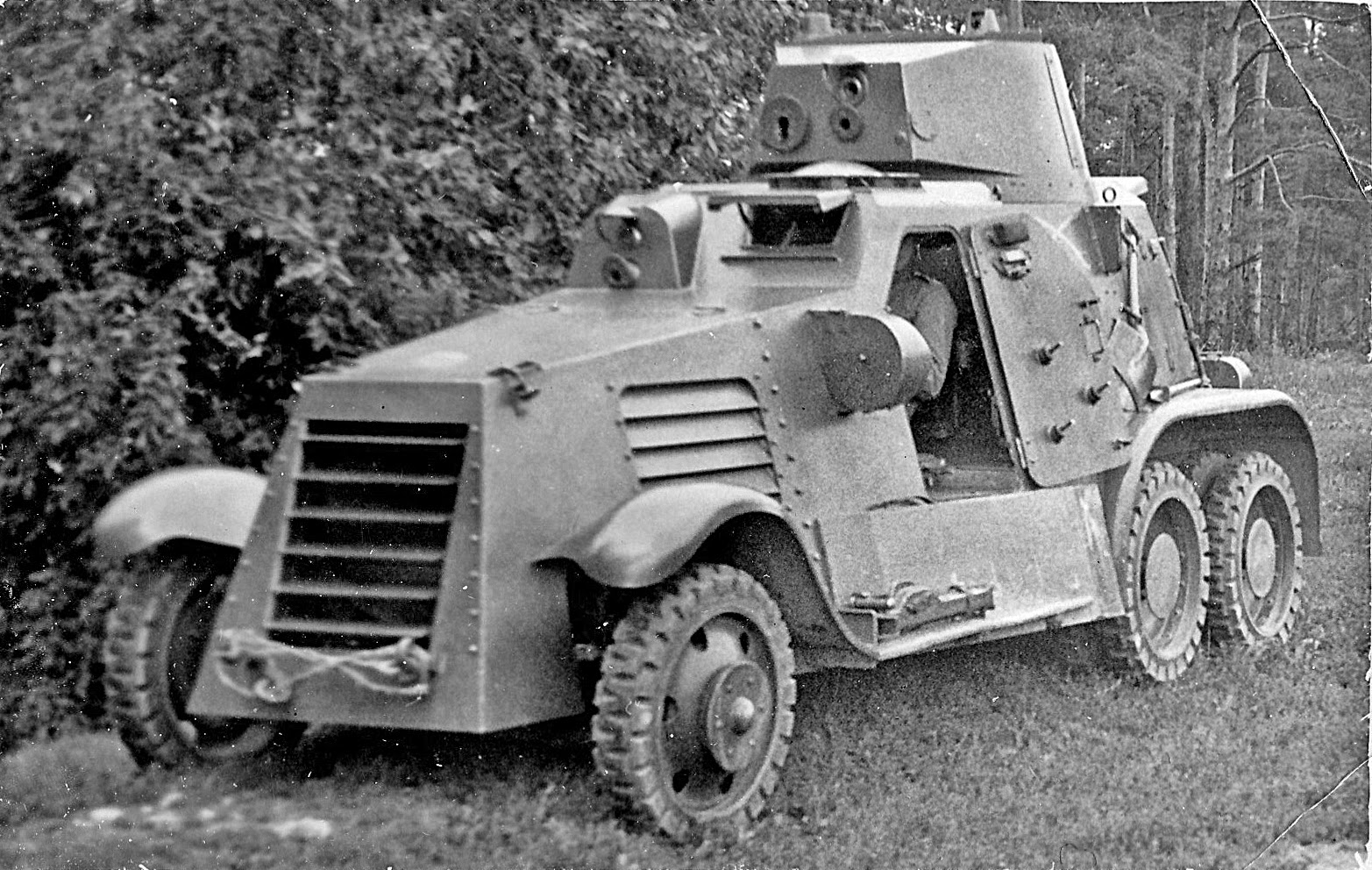Click on picture to enlarge
The original text from this album was written by Tyyne Kimpimaki
 |
| Tynne Maria Kimpimaki |
unfortunately we do not get the beauty of the music behind the text when translated into English, Thank you to my dear friends at Suomen Sukuhistoriallinen yhdistys for translating for me.
 |
Mänttä
municipality 26th November 1946
Dear brother Jussi
We will now let our brains rest and
bring you our daily life in pictures, so that you can yourself can see how
things are as good as you can yourself see. We have together with Tyyne search
our photo albums and picked out those photos we thought might interest you the
most. So we'll force you to worship photos and hope from our hearts that it'll
give you joy during the evenings and something to think about daytime.
with
photo regards Tyyne and Antti Uitto
and
family Hilkka and Eino Kimpimäki and families
|
 |
Picture #1
|
 |
Kimpimäki house where Jussi's "eyes saw first time the sky"
|
 |
Picture #2
|
 |
The Stable from Jussi's Design.
|
 |
Picture #3
|
 |
There is always room for you John at the Kimpimaki Table
|
 |
Picture #4
|
 |
There you have Father himself, leading his bunch of children. There's children from second, third generation
|
 |
Picture #5
|
 |
Täs'
on sitten suku suuri, puolelta isän lapsirikkaan - roughly translated:
Here you have the big family on father's side, with many children.
|
 |
Picture #6 Teofilus Kaisanpoika Peltoniemi
|
 |
The old man strengthening himself at the Lappeenranta party.
|
 |
Picture #7 Paavo Mannila (Sirri's Husband) and Teofilus Kaisanpoika Peltoniemi
|
 |
Masters of the house, the old one and the new one.
|
 |
Picture #8 Maiju-Kreta Kimpimäki
|
 |
The wise old lady of the house, who always had coffee in her pan - Maiju-Kreta Kimpimäki, who lived to be 91
|
 |
Picture #9 Teofilus Kaisanpoika Peltoniemi
|
 |
Grandfather's earthly journey has ended.
|
 |
Picture #10
|
 |
All faces are sad as the funeral car passes.
|
 |
Picture #11
|
 |
His last departure from the Kimpimäki yard.
|
 |
Picture #12
|
 |
Here is the stone which hides the remains of beloved elder which we all remember forever as our father.
|
 |
Picture #13
|
 |
There are only two families in this picture, although more could be expected from the number of people.
|
 |
Picture #14
|
 |
This large crowd gathered together once in the funeral of Mr. Martti.
|
 |
Picture #15
|
 |
| Far Left |
 |
| Far right |
 |
Hay and straw must be cut. Because all the men are in war, women have to do all the work.
|
 |
Picture #16
|
 |
These
youths are from Nurmo of the past. Time scattered them all around. If
this picture requires explanation, Kaisa, Heikki and Jaakko are the best
to give it.
|
 |
Picture #17 Tyyne, Irja, Kauko and Antti
|
 |
This is the family of Tyyne and Antti
a pack of kids where Irja is the oldest
so behind the time are these elders
and completely forgotten the Kimpmäki cottage
|
 |
Picture #18
|
 |
"Veneskoski bridge and shore, the place where "Antti got Tyyne {beside him) got Tyyne's cheek"
Notes:Here
You can find Veneskoski which is a part of Nurmo river (Nurmonjoki). I
suppose that bridge is in different place nowodays. Veneskoski is also
name of a village upon Nurmo river (Nurmonjoki). Googlemaps says same
river as Autionkoski River. Autionkoski is actually only a part of Nurmo
river and is found about 8 km away from Veneskoski. http://kansalaisen.karttapaikka.fi/linkki?scale=8000...
|
 |
Picture #19
Kustaa and Maija with their children Katri, Mirjam, Kerttu and Marjatta
|
 |
"Tässä itu on jo perheen soman
Kustaan ja Maijan ikioman.
Lapset: Katri, Mirjam
Kerttu ja Marjatta"
Here is a sprout (beginning) of cute family,
of Kustaa and Maija.
Children: Katri, Mirjam
Kerttu and Marjatta
Kustaa and Maija with their children Katri, Mirjam, Kerttu and Marjatta.
|
 |
Picture #20
Kauko and Irja, the children of Tyyne and Antti.
|
 |
"Pullukat ovat nää
Tyynen ja Antin
Kauko ja Irja"
Chubbies they are
Tyyne's and Antti's
|
 |
Picture #21
|
 |
Otinpa kerran tään morsiuskuvan
Nurkassa muistojen—edustuvan
Antti ja Tyyne Uitto
This is from my memories I once took this Bridal photo
in the "Edustupa"
Notes "Edustupa"
was a representation room where nobody lives. It was kept for guest's
bedroom and for feasts. Sometimes it was also for woodworks.
|
 |
Picture #22
Mirja child of Mirja's and Antti's
|
 |
God did not fail this child , he took her to angel's garden. Mirja child of Mirja's and Antti's...
|
 |
Picture #23 ?, ?, Tyyne
|
 |
The
Children Like the pig but Tyyne's mind keeps coming up Sausages.
|
 |
Picture #24 ?
|
 |
Picture #25 ?, Enio
|
 |
"Here is Eino seeking for happiness for the first time"
|
 |
Picture #26 ?
|
 |
But it only lasted for about a year as God had other plans.
|
 |
Picture #27 ?
|
 |
Eino
did find a new bride, pretty and his own for ever.
|
 |
Picture #28 Eino
|
 |
"Apparently selfish is this gent, who now started to show himself."
Eino
|
 |
Picture #29 Eino, ?, ?, ?
|
 |
Now Eino has got his family , there is one child missing from this photo.
|
 |
Picture #30 Marta
|
 |
"Here
then is our elderly sister Martta, whose gaze is avoiding all the men . Soon is
this girl will be an old maid, unless we brothers make her to hurry.
Notes "Kiirettä panna" is a dialect expression: ~ no put hurry..
|
 |
Picture #31, Eino, Jaakko, Herman and Arvi
|
 |
"Here is a pic of the time in the past, which does not need any explanation."
Eino Kimpimäki, Jaakko Kimpimäki, Herman Kimpimäki i.e. Amandas brothers, and Arvi Kimpimäki.
|
 |
Picture # 32 Back row ?, Heikki, Irja, ? front row ?, ? ?, ?
|
 |
Tässä kuva on Heikistä ja sen perillisistä
Here is a picture about Heikki and his heir
|
 |
Picture #33 Helm, Martti
|
 |
Tässä
lapsi on Joukon ja ensimmäinen, joka joutui jo sanomaan tahdon tai en
Here is a child of Jouko and the first one who have say I will or not
|
 |
Picture #34 Back Row ?, ?, Mauno Teofilus Pesari Front Row Ilona Katariina, ?
|
 |
"Family of Pesami? is this we see here, grown by sweat and work of Kaisa. Once a family of great bounty and now repaced with misfortune."
Notes: Kaisa's Husband Väinö Pesari died 07 Jun 1936 Lappeenranta, Finland
Son in Picture: Mauno
is buried in the 'hero cemetary' (war grave) in Lappeenranta among all the other local soldiers who died in the 2nd world war.
He died 10th of June 1944, just at the beginning of the 'suurhyökkäys', 'great offensive' (official name seems to
be Vyborg–Petrozavodsk Offensive, according to the Wikipedia). Based on
the date, my husband thinks that he might have died in Valkeasaari,
which would also explain the disappearing, the offensive was so bad that
the bodies just got destroyed in the attack.
This is the exact location in the graveyard he is buried: row 29 number 1304.
http://www.lappeenranta.fi/loader.aspx...
Pesari Mauno Teofilus 06.07.23 10.06.44 Lappeenranta 29 1304
|
 |
Picture #35 ?,?,?
|
 |
Picture #34 Arvi, Heikki and Eino
|
 |
Arvi,
Heikki ja Eino ovat kuvassa yllä ja vyötetty armeijan leijonavyöllä -
Arvi, Heikki and Eino are in the picture above, wearing the lion belt of
(Finnish) army
|
 |
Picture #35 ?, Erkki
|
 |
Here's a daughter also of Erkki Kimpimäki's binded strongly with hand
|
 |
Joukko
tässä on vallan sekalainen, jota johtaa appivanhukset Einon ja
ajatukseni sellainen että loppujen tuntemiseksi saat keksiä keinon
Here is a mixed set of people leaded by Eino's in-laws. And I think that
you will come up with a way to know the rest.
|
 |
Picture #36
|
 |
Picture #37
|
 |
Picture #38
|
 |
There is in Nurmo a rose and some others, like the gipsies above.
|
 |
Picture #39
|
 |
"War is familiar for us and you, but this is taken at school."
Notes:
Uudenmaan Rakuunapataljoona sijaitsi Lappeenrannassa (UudRakP) ja toimi itsenäisenä joukko-osastona vuoteen 1989.
The coat was called a skeleton coat for obvious reasons.
Cavalry! Rakuuna (with two u's) is derived from a French term dragon.
http://en.wikipedia.org/wiki/Dragoon
|
 |
Picture #40
|
 |
"This is a pride of the Finnish army, when will we see another one.
|
 |
Picture #41
|
 |
When studying the food is tasty,
|
 |
Picture #42
|
 |
Picture #43
|
 |
where as here the soup again to earth transforms. (toilets?)
Notes:
"Field toilets"obviously they are. There was also so call " Riuku"... wooden bar between two supporting stones.
|
 |
Picture #44
|
 |
"The war has reached us and you. Though here they are just studying. This wagon is wild but speed a little so that
|
 |
Picture #45
|
 |
—it can't compare to this
|
 |
| Add caption |
 |
Tää
vartija on Suomenlinnan, jonka nähdessään voi nostaa pystyyn rinnan.
This is the guard of The Fortress of Suomenlinna, the one you see you
can lift up your head.
|
 |
Tää
metsä joka näkyy tuolla, on saanut kranaattien pauhuun kuolla.
The
Forest you see here has got the death by the explosion of the granade
|
 |
Picture #42
|
 |
Picture #43
|
 |
Picture #44
|
 |
Picture #45
|
 |
One could sometimes visit on leave both
|
 |
Picture #46
|
 |
fetch prize from sports
|
 |
Picture #47
|
 |
and also — greet sibling
|
 |
Picture #48
|
 |
Tässä talo ompi uljas komentajan - jossa -
Here is gallant house of commander where
|
 |
Picture #49
|
 |
—beside is swimming platform that even in winter had to try
Vieressä on uimalava, joka talvellakin oli kokeiltava = Winter swimming.
|
 |
Picture #50
|
 |
—
Tässä talli ompi sotaratsun = This is a stable of the war-horse
|
 |
Picture #51
|
 |
Picture #52
|
 |
Picture #53
|
 |
Picture #54
|
 |
Picture #55
|
 |
Kas – katsotaankohan tässä,
kell’ on kymppi, kellä ässä.
The one where they're playing cards says something like "we will see who has a ten and who has an ace"
|
 |
Picture #56
|
"This is a dangerous job, we have to build a fence without the enemy noticing"
Vaarallista on homma tämä,
että aita tehdään vihollisen näkemänä.
 |
Picture #57
|
"In the evenings we sat in our war nest"
Illat istutaan sotapesässä.
 |
Picture #58
|
 |
Picture #59
|
 |
Picture #60
|
 |
Add caption
|
 |
Picture #61
|
 |
Picture #62
|
 |
A
picture of the Imatra water-power plant in south-eastern Finland built
in the late 1920´s. The locks are opened for some time during weekends
and tourist seasons to show the power and beauty of the rapids.
("this is a picture of the power of Imatra")
|
 |
Picture #63
|
 |
A riding horse ("ratsu")
|
 |
Picture #64
|
 |
A
primitive flat-splint slicer for making wooden splints to cover a roof.
It works much like a horizontally-moving guillotine and can be operated
manually by one person. The text is more or less a rhyme:
"Guess
why this apparatus is used for; it sways by the force of one man. It
cuts splints off the tree-trunk, and what do the boys bother of the rain
or anything else."
|
 |
Picture #65
|
 |
An autographed portrait of Markus Rautio (1891-1973)
Notes: an editor of the Finnish
Yleisradio (YLE), best known and loved as Uncle Markus for his
"Children´s Hour" in the radio 1926-1956. It was said that he (sadly)
hated children, but nothing could stop the children from loving him, and
taking much time from his favored work of conducting radio plays for
adults. He was not saved from the Children´s Hour until retiring from
the YLE. ("Uncle Markus here is the eternal uncle of Finnish children")
|
 |
Picture #66
|
 |
A
portrait of C.G.E. Mannerheim, the Marshall of Finland, (1867-1951)
Notes: the highest military rank ever used in Finland. Commander of the Finnish
army in 1918 and 1939-1945, and President 1944-1946. ("Our Marshall,
respected by everyone")
|


















































































































































